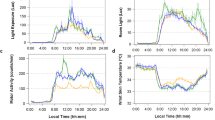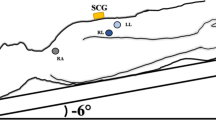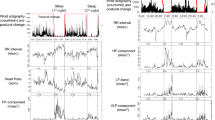Abstract
Purpose
Prolonged weightlessness exposure generates cardiovascular deconditioning, with potential implications on ECG circadian rhythms. Head-down (− 6°) tilt (HDT) bed rest is a ground-based analogue model for simulating the effects of reduced motor activity and fluids redistribution occurring during spaceflight. Our aim was to evaluate the impact of 60-day HDT on the circadianity of RR and ventricular repolarization (QTend) intervals extracted from 24-h Holter ECG recordings, scheduled 9 days before HDT (BDC-9), the 5th (HDT5), 21st (HDT21) and 58th (HDT58) day of HDT, the 1st (R + 0) and 8th (R + 7) day after HDT. Also, the effectiveness of a nutritional countermeasure (CM) in mitigating the HDT-related changes was tested.
Methods
RR and QTend circadian rhythms were evaluated by Cosinor analysis, resulting in maximum and minimum values, MESOR (a rhythm-adjusted mean), oscillation amplitude (OA, half variation within a night–day cycle), and acrophase (φ, the time at which the fitting sinusoid’s amplitude is maximal) values.
Results
RR and QTend MESOR increased at HDT5, and the OA was reduced along the HDT period, mainly due to the increase of the minima. At R + 0, QTend OA increased, particularly in the control group. The φ slightly anticipated during HDT and was delayed at R + 0.
Conclusion
60-Day HDT affects the characteristics of cardiac circadian rhythm by altering the physiological daily cycle of RR and QTend intervals. Scheduled day–night cycle and feeding time were maintained during the experiment, thus inferring the role of changes in the gravitational stimulus to determine these variations. The applied nutritional countermeasure did not show effectiveness in preventing such changes.





Similar content being viewed by others
Abbreviations
- BDC:
-
Baseline data collection
- CM:
-
Countermeasure
- CTRL:
-
Control
- ECG:
-
Electrocardiogram
- HDT:
-
Head-down tilt
- HR:
-
Heart rate
- OA:
-
Oscillation amplitude
- RR:
-
Time between two successive R waves
- QTend:
-
Time elapsed between the Q wave and the end of the T wave
References
Anzai T, Frey MA, Nogami A (2014) Cardiac arrhythmias during long-duration spaceflights. J Arrhythm 30:139–149. https://doi.org/10.1016/j.joa.2013.07.009
Baevsky RM, Baranov VM, Funtova II, Diedrich A, Pashenko AV, Chernikova AG, Drescher J, Jordan J, Tank J (2007) Autonomic cardiovascular and respiratory control during prolonged spaceflights aboard the International Space Station. J Appl Physiol 103:156–161. https://doi.org/10.1152/japplphysiol.00137.2007
Balk EM, Chung M, Lichtenstein AH, Chew PW, Kupelnick B, Lawrence A, Devine D, Lau J (2004) Effects of omega-3 fatty acids on cardiovascular risk factors and intermediate markers of cardiovascular disease. Evid Rep Technol Assess 93:1–6
Beckers F, Verheyden B, Aubert AE (2003) Evolution of heart rate variability before, during and after spaceflight. J Gravit Physiol A J Int Soc Gravitat Physiol 10:107–108
Beckers F, Verheyden B, Liu J, Aubert AE (2009) Cardiovascular autonomic control after short-duration spaceflights. Acta Astronaut 65:804–812. https://doi.org/10.1016/j.actaastro.2009.03.004
Bonmati-Carrion MA, Baño-Otalora B, Madrid JA, Rol MA (2017) Light color importance for circadian entrainment in a diurnal (Octodon degus) and a nocturnal (Rattus norvegicus) rodent. Sci Rep 7:8846. https://doi.org/10.1038/s41598-017-08691-7
Buijs FN, Leon-Mercado L, Guzman-Ruiz M, Guerrero-Vargas NN, Romo-Nava F, Buijs RM (2016) The circadian system: a regulatory feedback network of periphery and brain. Physiology (Bethesda) 31:170–181. https://doi.org/10.1152/physiol.00037.2015
Caiani EG, Martin-Yebra A, Landreani F, Bolea J, Laguna P, Vaïda P (2016) Weightlessness and cardiac rhythm disorders: current knowledge from space flight and bed-rest studies. Front Astron Space Sci 3:1–6. https://doi.org/10.3389/fspas.2016.00027
Chan MC, Spieth PM, Quinn K, Parotto M, Zhang H, Slutsky AS (2012) Circadian rhythms: from basic mechanisms to the intensive care unit. Crit Care Med 40(1):246–253. https://doi.org/10.1097/CCM.0b013e31822f0abe
Convertino V, Hoffler GW (1992) Cardiovascular physiology. Effects of microgravity. J Fla Med Assoc 79:517–524
D’Aunno DS, Dougherty AH, DeBlock HF, Meck JV (2003) Effect of short- and long-duration spaceflight on QTc intervals in healthy astronauts. Am J Cardiol 91(4):494–497. https://doi.org/10.1016/S0002-9149(02)03259-9
Du Pre BC, Van Laake LW, Meine M, Van der Heijden JF, Doevendans PA, Vos MA, Van Veen TAB (2017) Analysis of 24-h rhythm in ventricular repolarization identifies QT diurnality as a novel clinical parameter associated with previous ventricular arrhythmias in heart failure patients. Front Physiol 8:590. https://doi.org/10.3389/fphys.2017.00590
Erren TC, Reiter RJ (2009) Light hygiene: time to make preventive use of insights—old and new—into the nexus of the drug light, melatonin, clocks, chronodisruption and public health. Med Hypotheses 73:537–541. https://doi.org/10.1016/j.mehy.2009.06.003
Flynn-evans EE, Barger LK, Kubey AA, Sullivan JP, Czeisler CA (2016) Circadian misalignment affects sleep and medication use before and during space flight. Nat Publ Gr. https://doi.org/10.1038/npjmgrav.2015.19
Fritsch-Yelle JM, Charles JB, Jones MM, Beightol LA, Eckberg DL (1994) Spaceflight alters autonomic regulation of arterial pressure in humans. J Appl Physiol 77:1776–1783. https://doi.org/10.1152/jappl.1994.77.4.1776
Fritsch-Yelle JM, Charles JB, Jones MM, Wood ML (1996) Microgravity decreases heart rate and arterial pressure in humans. J Appl Physiol 80:910–914. https://doi.org/10.1152/jappl.1996.80.3.910
Fuller CA, Hoban-Higgins TM, Griffin DW, Murakami DM (1994) Influence of gravity on the circadian timing system. Adv Space Res 14:399–408. https://doi.org/10.1016/0273-1177(94)90431-6
Geleijnse JM, Giltay EJ, Grobbee DE, Donders AR, Kok FJ (2002) Blood pressure response to fish oil supplementation: metaregression analysis of randomized trials. J Hypertens 20:1493–1499. https://doi.org/10.1097/00004872-200208000-00010
Gopalakrishnan R, Genc KO, Rice AJ, Lee SM, Evans HJ, Maender CC, Ilaslan H, Cavanagh PR (2010) Muscle volume, strength, endurance, and exercise loads during 6-month missions in space. Aviat Space Environ Med 81:91–102. https://doi.org/10.3357/ASEM.2583.2010
Gundel A, Polyakov VV, Zulley J (1997) The alteration of human sleep and circadian rhythms during spaceflight. J Sleep Res 6:1–8. https://doi.org/10.1046/j.1365-2869.1997.00028.x
Jeyaraj D, Haldar SM, Wan X, McCauley MD, Ripperger JA, Hu K, Lu Y, Eapen BL, Sharma N, Ficker E, Cutler MJ, Gulick J, Sanbe A, Robbins J, Demolombe S, Kondratov RV, Shea SA, Albrecht U, Wehrens XHT, Rosenbaum DS, Jain MK (2012) Circadian rhythms govern cardiac repolarization and arrhythmogenesis. Nature 483(7387):96–99. https://doi.org/10.1038/nature10852
Jiddou MR, Pica M, Boura J, Qu L, Franklin BA (2013) Incidence of myocardial infarction with shifts to and from daylight savings time. Am J Cardiol 111(5):631–635. https://doi.org/10.1016/j.amjcard.2012.11.010
Kang JX, Leaf A (1996) Antiarrhythmic effects of polyunsaturated fatty acids. Recent Stud Circ 94(7):1774–1780. https://doi.org/10.1161/01.cir.94.7.1774
Kirchberger I, Wolf K, Heier M, Kuch B, von Scheidt W, Peters A, Meisinger C (2015) Are daylight saving time transitions associated with changes in myocardial infarction incidence? Results from the German MONICA/KORA Myocardial Infarction Registry. BMC Public Health 15:778. https://doi.org/10.1186/s12889-015-2124-4
Liang X, Zhang L, Wan Y, Yu X, Guo Y, Chen X, Tan C, Huang T, Shen H, Chen X, Li H, Lv K, Sun F, Chen S, Guo J (2012) Changes in the diurnal rhythms during a 45-day head-down bed rest. PLoS ONE 7(10):e47984. https://doi.org/10.1371/journal.pone.0047984
Liang X, Zhang L, Shen H, Chen X, Wan Y, Li L, Liang Y, Yu X, Guo Y, Yu J, Shu W, Tan C, Lv K, Xiao Y, Chen X, Chen S, Guo J (2014) Effects of a 45-day head-down bed rest on the diurnal rhythms of activity, sleep, and heart rate. Biol Rhythm Res 45:591–601. https://doi.org/10.1080/09291016.2014.882093
Liu J, Li Y, Verheyden B, Chen Z, Wang J, Li Y, Aubert AE, Yuan M (2015) Orthostatic intolerance is independent of the degree of autonomic cardiovascular adaptation after 60 days of head-down bed rest. Biomed Res Int. https://doi.org/10.1155/2015/896372
Logan RW, McClung CA (2019) Rhythms of life: circadian disruption and brain disorders across the lifespan. Nat Rev Neurosci 20:49–65. https://doi.org/10.1038/s41583-018-0088-y
Manfredini R, Fabbian F, Cappadona R, Modesti PA (2018) Daylight saving time, circadian rhythms, and cardiovascular health. Intern Emerg Med 13:641–646. https://doi.org/10.1007/s11739-018-1900-4
Martín-Yebra A, Monasterio V, Landreani F, Laguna P, Pablo Martínez J, Caiani EG (2019) Assessment of ventricular repolarization instability in terms of T-wave alternans induced by head-down bed-rest immobilization. Physiol Meas 40(10):104001. https://doi.org/10.1088/1361-6579/ab4c18
McKenna HT, Reiss IK, Martin DS (2017) The significance of circadian rhythms and dysrhythmias in critical illness. J Intensive Care Soc 18(2):121–129. https://doi.org/10.1177/1751143717692603
Morris CJ, Purvis TE, Hu K, Scheer FAJL (2016) Circadian misalignment increases cardiovascular disease risk factors in humans. Proc Natl Acad Sci USA 113:E1402–E1411. https://doi.org/10.1073/pnas.1516953113
Mozaffarian D, Prineas RJ, Stein PK, Siscovick DS (2006) Dietary fish and n-3 fatty acid intake and cardiac electrocardiographic parameters in humans. J Am Coll Cardiol 48(3):478–484. https://doi.org/10.1016/j.jacc.2006.03.048
Ohlander J, Keskin MC, Stork J, Radon K (2015) Shift work and hypertension: prevalence and analysis of disease pathways in a German car manufacturing company. Am J Ind Med 58:549–560. https://doi.org/10.1002/ajim.22437
Pavy-Le Traon A, Heer M, Narici MV, Rittweger J, Vernikos J (2007) From space to Earth: advances in human physiology from 20 years of bed rest studies (1986–2006). Eur J Appl Physiol 101:143–194. https://doi.org/10.1007/s00421-007-0474-z
Rambaut PC, Leach CS, Leonard JI (1977) Observations in energy balance in man during spaceflight. Am J Physiol Integr Comp Physiol 233:R208–R212. https://doi.org/10.1152/ajpregu.1977.233.5.R208
Refinetti R, Lissen GC, Halberg F (2007) Procedures for numerical analysis of circadian rhythms. Biol Rhythm Res 38:275–325. https://doi.org/10.1080/09291010600903692
Roenneberg T, Merrow M (2016) The circadian clock and human health. Curr Biol 26(10):R432–R443. https://doi.org/10.1016/j.cub.2016.04.011
Santy PA, Kapanka H, Davis JR, Stewart DF (1988) Analysis of sleep on shuttle missions. Aviat Space Environ Med 59:1094–1097
Smith SM, Heer M (2002) Calcium and bone metabolism during space flight. Nutrition 18:849–852. https://doi.org/10.1016/S0899-9007(02)00895-X
Verheyden B, Beckers F, Couckuyt K, Liu J, Aubert AE (2007) Respiratory modulation of cardiovascular rhythms before and after short-duration human spaceflight. Acta Physiol 191:297–308. https://doi.org/10.1111/j.1748-1716.2007.01744.x
Watenpaugh DE (2016) Analogs of microgravity: head-down tilt and water immersion. J Appl Physiol 120:904–914. https://doi.org/10.1152/japplphysiol.00986.2015
Wu B, Wang Y, Wu X, Liu D, Xu D, Wang F (2018) On-orbit sleep problems of astronauts and countermeasures. Mil Med Res 5:1–12. https://doi.org/10.1186/s40779-018-0165-6
Yamamoto N, Otsuka K, Kubo Y, Hayashi M, Mizuno K, Ohshima H, Mukai C (2015) Effects of long-term microgravity exposure in space on circadian rhythms of heart rate variability. Chronobiol Int 32:327–340. https://doi.org/10.3109/07420528.2014.979940
Acknowledgements
This work was supported by the Italian Space Agency (contract 2018-7-U.0, recipient E. G. Caiani).
Author information
Authors and Affiliations
Contributions
EC and PV conceived and designed the research. FL conducted experiments. AM contributed to the development of analytical tools. SS and MT analysed data. LC contributed with medical interpretation of the results. SS and EC wrote the manuscript. All authors read and approved the manuscript.
Corresponding author
Ethics declarations
Conflict of interest
The authors declare that they have no conflict of interest.
Additional information
Communicated by Keith Phillip George.
Publisher's Note
Springer Nature remains neutral with regard to jurisdictional claims in published maps and institutional affiliations.
Rights and permissions
About this article
Cite this article
Solbiati, S., Landreani, F., Turcato, M. et al. Analysis of changes in cardiac circadian rhythms of RR and QT induced by a 60-day head-down bed rest with and without nutritional countermeasure. Eur J Appl Physiol 120, 1699–1710 (2020). https://doi.org/10.1007/s00421-020-04404-7
Received:
Accepted:
Published:
Issue Date:
DOI: https://doi.org/10.1007/s00421-020-04404-7




